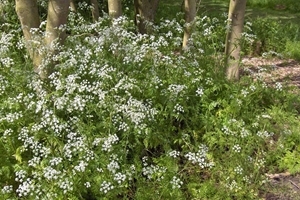Cow parsley
 This member of the carrot family is very common in Britain, Ireland and most of northern Europe and adorns most roadside verges at this time of year. Cow parsley (Anthriscus sylvestris) is a hollow-stemmed, tall plant that grows rapidly in April, coming into flower with a mass of white flowers in May, and lasts through to June.
This member of the carrot family is very common in Britain, Ireland and most of northern Europe and adorns most roadside verges at this time of year. Cow parsley (Anthriscus sylvestris) is a hollow-stemmed, tall plant that grows rapidly in April, coming into flower with a mass of white flowers in May, and lasts through to June.
Cow parsley has many country names, such as wild chervil and Queen Anne’s lace. There are many stories to explain the origins of this latter name. Some say as Queen Anne travelled around the country in May, she thought that the roadsides had been specifically decorated for her! Others claimed that as Queen Anne suffered from asthma, she would often take walks in the countryside for fresh air. As she passed the flowers of cow parsley, they reminded her of the lace pillows that her ladies-in-waiting carried, and so created this name for them.
Another name commonly come across is ‘mother-die’, as folklore suggests that your mother would die if the plant was taken indoors. I wonder if this stems from the fact that the poisonous hemlock plant looks quite similar.
In my childhood, I remember people calling the plant ‘keck’ but never really questioned why or what it meant. The dictionary definition of keck means to feel as if one is about to vomit or retch. Now, I know that the smell of cow parsley is a bit of a Marmite subject, with some people finding it quite pleasant – a cross between parsley and aniseed. But others hate the smell, saying that it is over-dominant and horrible – maybe enough even to make you keck?
I love one old story from the Cotswolds: “Growing up in the Cotswolds, we always called cow parsley ‘keck’. I remember as a young boy hearing old men discussing a young motorcyclist with a habit for reckless speed on winding lanes, ‘going round the bends with his yud [head] in the keck’.” Wonderful!
One final name to admire is ‘dog’s flourish’. An elderly lady from central west Scotland always knew the flower by this name, saying: “Well, it grows well on the verges where the dogs have been!”
So, the plant obviously likes high fertility. Simon Smart, from the Centre for Ecology and Hydrology in Lancaster, dug out some fascinating figures from the Countryside Survey, the enormous census of the habitats and vegetation of rural Britain that the government carries out every ten years. These made it clear that cow parsley is very much undergoing a boom.
On monitored plots along linear landscape features such as road edges, the survey found that between 1978 and 2007 the plots in which cow parsley occurred increased in Britain from 129 to 204 (a 58 per cent increase).
But why is it happening? There seem to be two reasons: the way we manage roadside verges today, and the increased fertility of the landscape as a result of intensive farming.
In the past, Smart said, verges were often grazed by farm animals, or they were cut for hay, and the grass and other plants, once mown, were taken off. Now they are mown by local councils, and the mowings are merely left in place, which adds nutrients to the soil and makes it more fertile. And soil fertility is being increased further by the fertilisers farmers now add to the landscape, and even by motor vehicle exhausts, which add their own nutrients to roadside verges in the form of oxides of nitrogen.
As one cow parsley plant can yield between 800 to 10,000 seeds, you can see that colonisation can quickly take place if the conditions are right. Many botanists dislike the plant, believing that it is smothering out less aggressive plants and diminishing the diversity of our roadside verges.
The dried roots of cow parsley are used, mixed with other species, as a haematinic and tonic in Chinese medicine, but until recently it has been largely ignored in the west.
However, researchers at the University of Padova in Italy studied several plant species when looking for a source of the lignin podophyllotoxin, which as a result of recent research has shown promise as a starting compound for the production of several anti-cancer drugs.
Scientists have always struggled to find a good source of lignins until it was discovered that the entire cow parsley plant is a source of the closely related deoxypodophyllotoxin, with highest concentrations in the roots. Studies in South Korea have shown that this substance also induces cell cycle arrest, followed by cell death, in cervical carcinoma cells.
So, it is now hoped that cow parsley could provide a cheap and abundant alternative source of these lignins.
How incredible to think that this plentiful plant, which many of us rush by on a daily basis without so much as a glance, could one day help to save lives!
Peter Thompson
Advisory
Read more from Peter Thompson at his blog.
Get the Latest News & Advice
Join over 100,000 subscribers and stay updated on our latest advice, research, news and offers.
*You may change your mind any time. For more information, see our Privacy Policy.